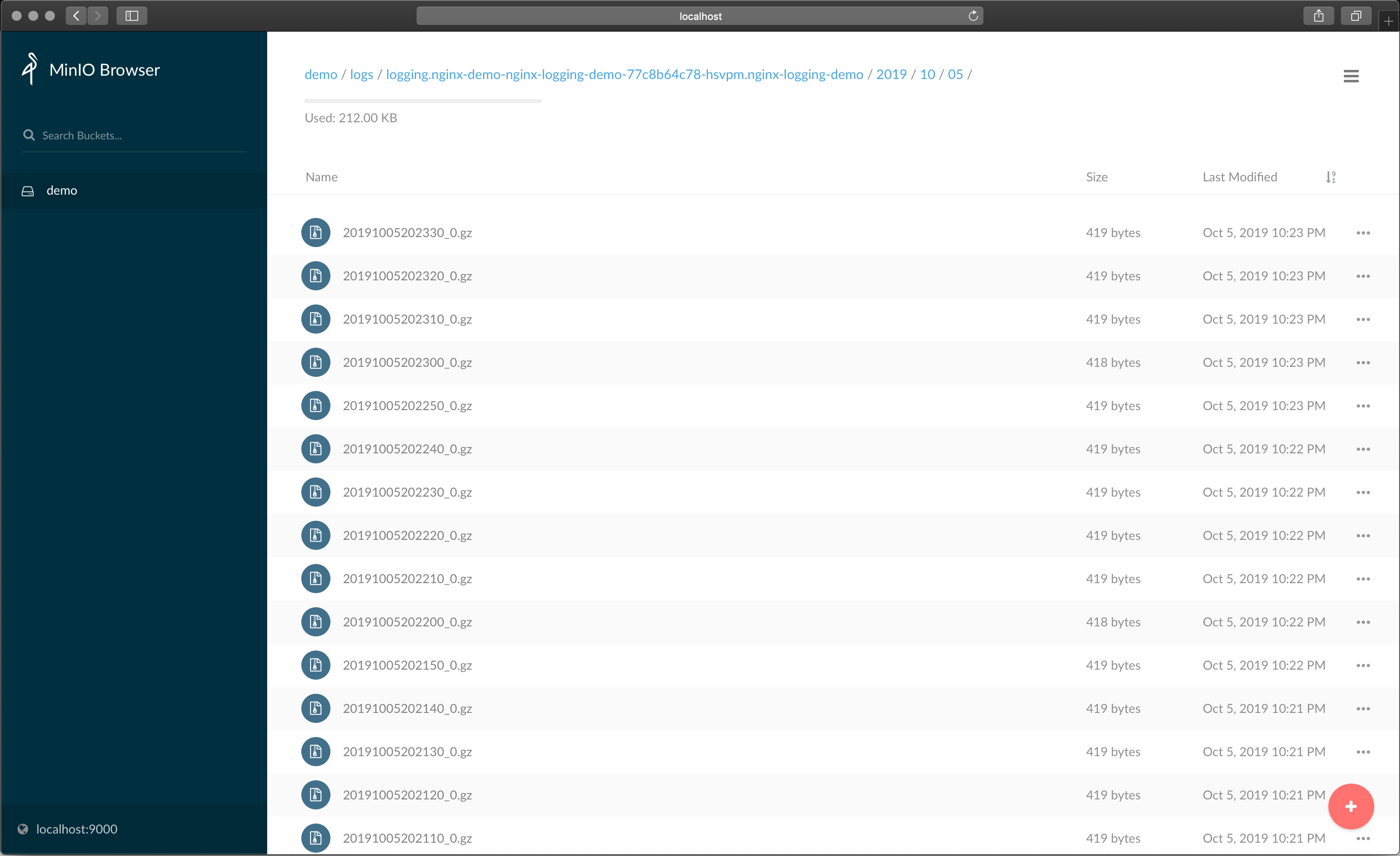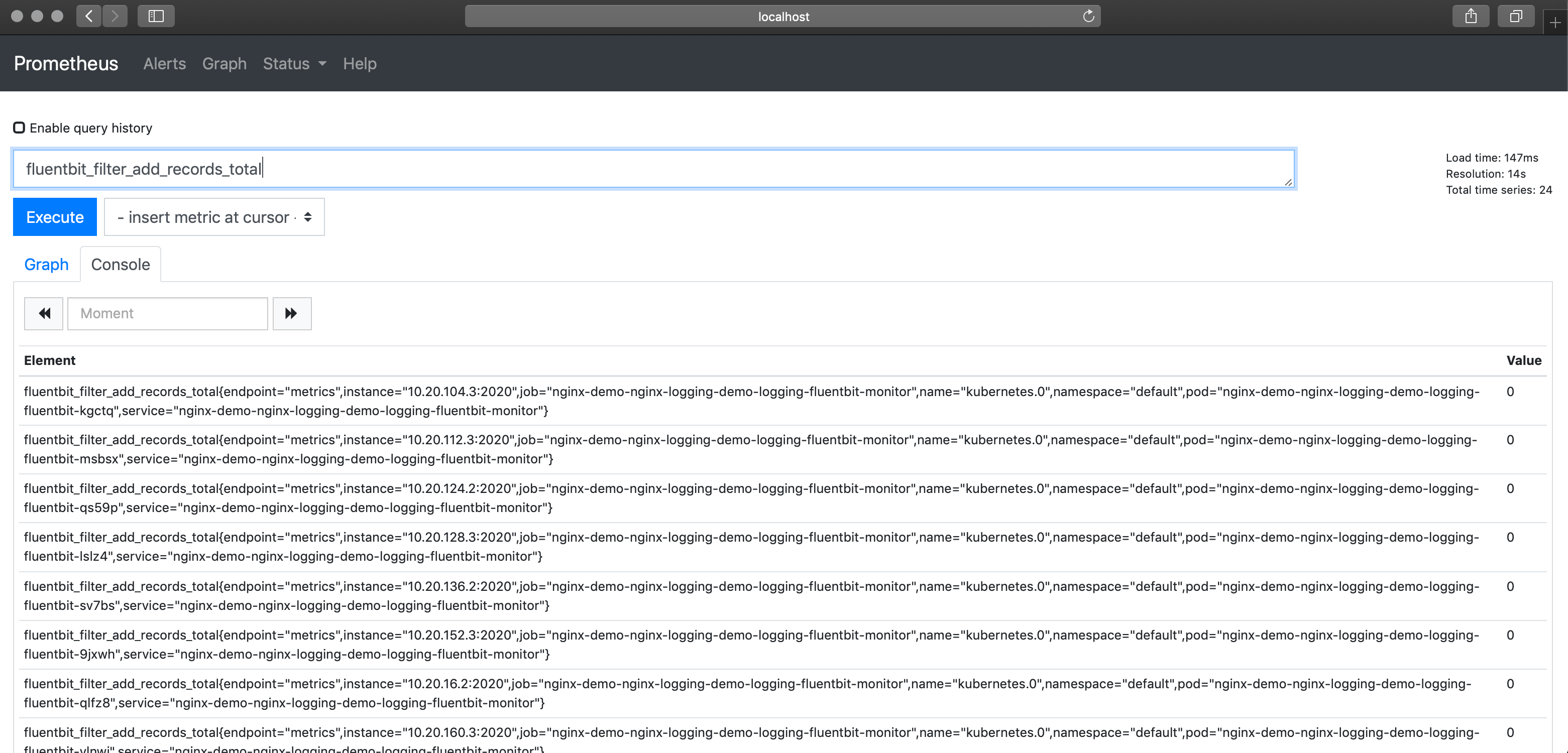

You can configure the Logging operator to expose metrics endpoints for Fluentd, Fluent Bit, and syslog-ng using ServiceMonitor resources. That way, a Prometheus operator running in the same cluster can automatically fetch your logging metrics.
Metrics Variables 🔗︎
You can configure the following metrics-related options in the fluentdSpec, syslogNGSpec, and fluentbitSpec sections of your Logging resource.
| Variable Name | Type | Required | Default | Description |
|---|---|---|---|---|
| interval | string | No | “15s” | Scrape Interval |
| timeout | string | No | “5s” | Scrape Timeout |
| port | int | No | - | Metrics Port. |
| path | int | No | - | Metrics Path. |
| serviceMonitor | bool | No | false | Enable to create ServiceMonitor for Prometheus operator |
| prometheusAnnotations | bool | No | false | Add prometheus labels to fluent pods. |
For example:
spec:
fluentdSpec:
metrics:
serviceMonitor: true
fluentbitSpec:
metrics:
serviceMonitor: true
syslogNGSpec:
metrics:
serviceMonitor: true
For more details on installing the Prometheus operator and configuring and accessing metrics, see the following procedures.
Install Prometheus Operator with Helm 🔗︎
-
Create
loggingnamespacekubectl create namespace logging -
Install Prometheus Operator
helm upgrade --install --wait --create-namespace --namespace logging monitor stable/prometheus-operator \ --set "grafana.dashboardProviders.dashboardproviders\\.yaml.apiVersion=1" \ --set "grafana.dashboardProviders.dashboardproviders\\.yaml.providers[0].orgId=1" \ --set "grafana.dashboardProviders.dashboardproviders\\.yaml.providers[0].type=file" \ --set "grafana.dashboardProviders.dashboardproviders\\.yaml.providers[0].disableDeletion=false" \ --set "grafana.dashboardProviders.dashboardproviders\\.yaml.providers[0].options.path=/var/lib/grafana/dashboards/default" \ --set "grafana.dashboards.default.logging.gnetId=7752" \ --set "grafana.dashboards.default.logging.revision=5" \ --set "grafana.dashboards.default.logging.datasource=Prometheus" \ --set "prometheus.prometheusSpec.serviceMonitorSelectorNilUsesHelmValues=False"Prometheus Operator Documentation The prometheus-operator install may take a few more minutes. Please be patient. The logging-operator metrics function depends on the prometheus-operator’s resources. If those do not exist in the cluster it may cause the logging-operator’s malfunction.
Install with Helm 🔗︎
-
Add operator chart repository:
helm repo add banzaicloud-stable https://kubernetes-charts.banzaicloud.com -
Logging Operator
helm upgrade --install --wait --create-namespace --namespace logging logging banzaicloud-stable/logging-operator -
Deploy Demo App + Logging Definition with metrics
helm upgrade --install --wait --create-namespace --namespace logging logging-demo banzaicloud-stable/logging-demo \ --set "minio.enabled=True" \ --set=loggingOperator.fluentd.metrics.serviceMonitor=True \ --set=loggingOperator.fluentbit.metrics.serviceMonitor=True
Install from manifest 🔗︎
Install Minio 🔗︎
-
Create Minio Credential Secret
kubectl -n logging create secret generic logging-s3 --from-literal=accesskey='AKIAIOSFODNN7EXAMPLE' --from-literal=secretkey='wJalrXUtnFEMI/K7MDENG/bPxRfiCYEXAMPLEKEY' -
Deploy Minio
kubectl -n logging apply -f - <<"EOF" apiVersion: apps/v1 kind: Deployment metadata: name: minio-deployment namespace: logging spec: selector: matchLabels: app: minio strategy: type: Recreate template: metadata: labels: app: minio spec: containers: - name: minio image: minio/minio args: - server - /storage readinessProbe: httpGet: path: /minio/health/ready port: 9000 initialDelaySeconds: 10 periodSeconds: 5 env: - name: MINIO_REGION value: 'test_region' - name: MINIO_ACCESS_KEY valueFrom: secretKeyRef: name: logging-s3 key: accesskey - name: MINIO_SECRET_KEY valueFrom: secretKeyRef: name: logging-s3 key: secretkey ports: - containerPort: 9000 volumes: - name: logging-s3 secret: secretName: logging-s3 --- kind: Service apiVersion: v1 metadata: name: nginx-demo-minio namespace: logging spec: selector: app: minio ports: - protocol: TCP port: 9000 targetPort: 9000 EOF -
Create
loggingresourcekubectl -n logging apply -f - <<"EOF" apiVersion: logging.banzaicloud.io/v1beta1 kind: Logging metadata: name: default-logging-simple spec: fluentd: metrics: serviceMonitor: true fluentbit: metrics: serviceMonitor: true controlNamespace: logging EOFNote:
ClusterOutputandClusterFlowresource will only be accepted in thecontrolNamespace -
Create Minio output definition
kubectl -n logging apply -f - <<"EOF" apiVersion: logging.banzaicloud.io/v1beta1 kind: Output metadata: name: demo-output spec: s3: aws_key_id: valueFrom: secretKeyRef: key: accesskey name: logging-s3 aws_sec_key: valueFrom: secretKeyRef: key: secretkey name: logging-s3 buffer: timekey: 10s timekey_use_utc: true timekey_wait: 0s force_path_style: "true" path: logs/${tag}/%Y/%m/%d/ s3_bucket: demo s3_endpoint: http://nginx-demo-minio.logging.svc.cluster.local:9000 s3_region: test_region EOFNote: For production set-up we recommend using longer
timekeyinterval to avoid generating too many object. -
Create
flowresourcekubectl -n logging apply -f - <<"EOF" apiVersion: logging.banzaicloud.io/v1beta1 kind: Flow metadata: name: demo-flow spec: filters: - tag_normaliser: {} - parser: remove_key_name_field: true reserve_data: true parse: type: nginx match: - select: labels: app.kubernetes.io/instance: nginx-demo app.kubernetes.io/name: nginx-logging-demo localOutputRefs: - demo-output EOF -
Install test deployment
kubectl -n logging apply -f - <<"EOF" apiVersion: apps/v1 kind: Deployment metadata: name: nginx-deployment spec: selector: matchLabels: app: nginx replicas: 1 template: metadata: labels: app: nginx spec: containers: - name: nginx image: banzaicloud/loggen:latest EOF
Validation 🔗︎
Minio 🔗︎
-
Get Minio login credentials
kubectl -n logging get secrets logging-s3 -o json | jq '.data | map_values(@base64d)' -
Forward Service
kubectl -n logging port-forward svc/nginx-demo-minio 9000 -
Open the Minio Dashboard: http://localhost:9000

Prometheus 🔗︎
-
Forward Service
kubectl port-forward svc/monitor-prometheus-operato-prometheus 9090 -
Open the Prometheus Dashboard: http://localhost:9090

Grafana 🔗︎
-
Get Grafana login credentials
kubectl get secret --namespace logging monitor-grafana -o jsonpath="{.data.admin-password}" | base64 --decode ; echoDefault username:
admin -
Forward Service
kubectl -n logging port-forward svc/monitor-grafana 3000:80 -
Open Gradana Dashboard: http://localhost:3000














